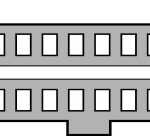Finding yourself staring at a frustrating check engine light in your Chevy Tracker but don’t have an OBD2 scanner? Don’t worry, you’re not alone. This guide will walk you through some simple methods to check OBD2 codes on your Chevy Tracker without a scanner. While a dedicated scanner offers more comprehensive data, these techniques can provide valuable clues about the issue.
Utilizing the Paperclip Method
For Chevy Trackers manufactured between 1999 and 2004, you can use the paperclip trick to retrieve OBD2 codes. This involves jumping specific pins on the Diagnostic Link Connector (DLC) located under the dashboard, typically near the steering column.
Here’s how to do it:
- Locate the DLC: Look for a black, rectangular connector with 16 pins.
- Turn the ignition to the “ON” position: Don’t start the engine.
- Use a paperclip or small wire: Straighten the paperclip and bend it into a “U” shape.
- Jump the pins: Insert one end of the paperclip into pin A and the other into pin B of the DLC. Refer to your vehicle’s repair manual for the precise location of pins A and B, as they can vary slightly.
- Observe the Check Engine Light (CEL): The CEL will begin to flash a series of codes. Long flashes represent the tens digit, and short flashes represent the ones digit. A code is separated by a brief pause. For example, two long flashes followed by three short flashes indicate code 23.
- Record the codes: Write down the codes in the order they appear.
- Interpret the codes: Consult a Chevy Tracker repair manual or search online for OBD2 code definitions to understand what each code signifies.
Observing the “Service Engine Soon” Light Behavior
While less precise than the paperclip method, observing the behavior of the “Service Engine Soon” light can sometimes provide hints about potential problems. A steadily illuminated light generally indicates a less serious issue, while a flashing light often signifies a more urgent problem requiring immediate attention to prevent potential engine damage. This method won’t provide specific codes, but it can indicate the severity of the issue.
Limitations of DIY Methods
It’s crucial to understand that these methods have limitations. They primarily work on older Chevy Trackers and may not be effective on newer models. They also offer less detailed information than a professional OBD2 scanner.
When to Use a Professional OBD2 Scanner
For more comprehensive diagnostics, especially on newer Chevy Trackers, a professional OBD2 scanner is recommended. These scanners provide detailed information beyond basic codes, including freeze frame data, live sensor readings, and the ability to clear codes after repairs. Investing in a quality scanner or visiting a qualified mechanic is the most reliable way to accurately diagnose and address check engine light issues.
While checking OBD2 codes without a scanner on a Chevy Tracker is possible using the methods outlined above, remember that a professional scan provides the most accurate and detailed information. If you’re unsure about performing these procedures yourself, consult a qualified mechanic for assistance.

